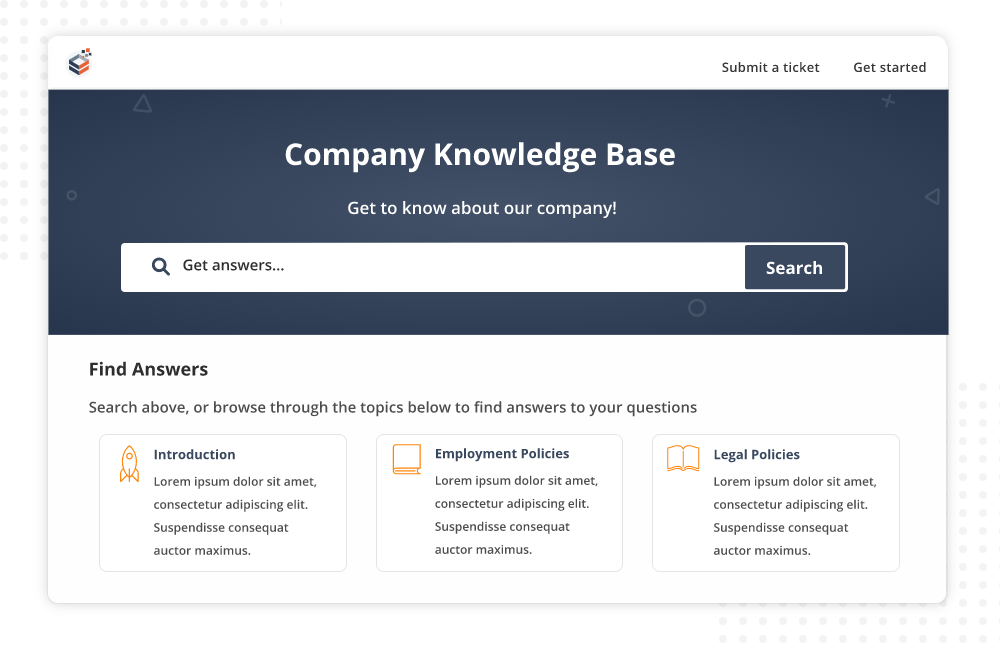The significance of knowledge transfer in today’s business landscape cannot be overstated. This process of sharing or disseminating knowledge from one part of the organization to another addresses several challenges, like the loss of institutional knowledge when employees leave.
A from McKinsey & Company reveals that employees spend nearly 20% of their workweek searching for internal information or tracking down colleagues who can help with specific tasks.
Effective knowledge transfer mitigates these issues by ensuring that vital information is retained and easily accessible, enhancing productivity and innovation.
In this blog, we will explore the numerous benefits of knowledge transfer, real-world use cases, and practical steps to implement it effectively within your organization.
What Is Knowledge Transfer?
Knowledge transfer is a well-defined process of capturing and storing employees’ valuable knowledge on a centralized platform, so it can be easily accessed by everyone in your organization. Regardless of who leaves and who joins, the knowledge employees gain in their tenure stays with you forever.
This central source of information eliminates the hassle of digging through emails, documents, and Google Drive, thus improving workforce productivity.
Why Knowledge Transfer Matters for Your Business?
Knowledge transfer is crucial for effective business operations, enabling organizations to leverage collective expertise and experience. By facilitating the seamless exchange of information, businesses can address challenges more efficiently and innovate more rapidly.
Here’s why knowledge transfer matters for your business problem-solving efforts:
Enhancing Decision-Making
Effective transfer of knowledge empowers employees with the information they need to make informed decisions.
When knowledge is shared across the organization, decision-makers have access to diverse insights and historical data, enabling them to consider multiple perspectives and make more well-rounded choices.
Reducing Redundancy
One common problem in businesses is the duplication of efforts, where multiple teams or individuals work on solving the same problem without realizing it.
Knowledge transfer helps eliminate this redundancy by ensuring that information about ongoing projects and past solutions is readily accessible. This not only saves time and resources but also fosters a more collaborative and efficient work environment.
Accelerating Innovation
Innovation thrives in an environment where knowledge flows freely. By sharing expertise, experiences, and best practices, employees can build on each other’s ideas and create innovative solutions to complex problems.
This is because knowledge transfer breaks down silos and encourages cross-functional collaboration, leading to the development of new and improved products, services, and processes.
Improving Employee Onboarding & Training
Knowledge transfer is vital for onboarding new employees and providing ongoing training. When new hires have access to a well-organized knowledge base, they can quickly become familiar with company processes, policies, and projects. This reduces the learning curve and allows them to contribute more effectively from the outset.
Moreover, continuous knowledge sharing ensures that employees stay updated with the latest industry trends and organizational changes, enhancing their overall performance and job satisfaction.
Ensuring Business Continuity
In today’s dynamic business environment, employee turnover is inevitable. Effective knowledge transfer ensures that critical information is not lost when employees leave the organization.
By systematically capturing and disseminating knowledge, businesses can maintain continuity and avoid disruptions in operations.
Boosting Customer Satisfaction
When employees are well-informed and can access relevant information quickly, they are better equipped to meet customer needs and resolve issues promptly.
Knowledge transfer enhances customer service by providing employees with the tools and knowledge they need to deliver exceptional service. Effective knowledge transfer helps meet these expectations, leading to higher customer satisfaction and loyalty.
What Are the Use Cases of Knowledge Transfer?
While most experts will tell you what knowledge transfer is, very few will be able to divulge the details of how it works!
Well, you will not be disappointed here. We did our research and have collated all the possible ways knowledge transfer can be used.
The uses of knowledge transfer and knowledge sharing platforms are manifold. Let’s look at some of the most significant ones:
- Equips employees with instant access to department-specific best practices and subject matter expertise
- Considers each employee as a valuable resource whose contributions can bring real value to your business
- Reduces the occurrence of repetitive errors in performing tasks and conducting processes
- Saves employees from the tedious task of searching for information scattered across emails, excel sheets, and PPTs
- Boosts workforce efficiency by giving 24×7 access to company knowledge
All of this combined has a snowball effect on how your business operates and grows. From customer service to sales and marketing, there is a positive impact on each department and an increased scope for innovation.
How to Effectively Transfer Knowledge?
For systematic knowledge transfer, start by creating a knowledge-sharing culture where employees come together to share their insights and experiences. Next, you need to document, organize, and improve this knowledge periodically.
Let’s look at these steps in detail.
1. Build a System to Capture Knowledge
A knowledge-sharing culture is crucial for successful knowledge transfer. You need to focus on initiating activities that promote this culture. Put efforts into bringing your teams together and ask them to share their expertise and experiences.
You can organize brainstorming sessions for knowledge transfer, ask for solutions to business problems, and involve subject-matter experts in the process. You can also seek insights from department heads and those who have been working in your organization for a long time. Veteran employees can also attend training sessions that help spark meaningful conversations in teams.
As a company that values knowledge, your goal should be to create a centralized repository of all the captured information so it never gets lost.
2. Store Information in an Internal Knowledge Base
How to Create an Internal Knowledge Base For Employees
A cloud-based knowledge base equips your teams with the necessary infrastructure to create helpful articles enriched with images and videos. A knowledge base is a great platform to document both explicit knowledge and tacit knowledge that saves employees from the chaos of emails and Google Drives.
What’s really fascinating about this platform is its ease of access. Employees can get everything they need in a heartbeat. There is no juggling between multiple documents—just one platform where they can find all insights and best practices.
With knowledge at their fingertips, employees can work more efficiently and make informed decisions on time.
3. Share Knowledge With Multiple Teams
You need a well-defined process that facilitates quick knowledge transfer to new employees as well as existing ones. Start by creating a process document stating the key rules of knowledge sharing that employees must follow.
Building a dedicated team of knowledge transfer specialists who can oversee the entire process from start to end. This team will make key decisions regarding which channels to include and which teams to cover. Additionally, the team will be responsible for the timely dissemination of information.
In addition, you need the support of the right knowledge transfer software, which can accelerate information circulation and ensure it’s done at a deeper level, covering all departments and teams.
4. Measure Knowledge Transfer Success
The ultimate goal of knowledge transfer is to capture knowledge from key employees and create a factory of valuable information. If this database is not updated regularly, it can become stale and useless.
Keeping a constant check on how information is being used is therefore important. By deploying a powerful knowledge base tool, you can track KPIs and measure the effectiveness of the content. With KPIs like article upvotes and downvotes, and failed and successful searches, it’s possible to identify what’s working and what’s not working with employees.
Use this data to understand what your employees are looking for and whether they are finding the right answers. Based on your analysis, ask your department heads or subject matter experts to revise irrelevant articles and create educational content on the topics employees are searching for.
FREE. All Features. FOREVER!
Try our Forever FREE account with all premium features!
How to Create a Knowledge Transfer Plan
A knowledge transfer plan lays the foundation for circulating knowledge effectively across your organization. It gives you a defined path to channeling your efforts and achieving the maximum results from your knowledge transfer initiatives.
Follow these simple steps to create a result-focused knowledge transfer plan:
1. Set Clear Goals
This is the very first thing you need to do while creating a knowledge transfer plan. To gain clarity regarding your goals, you need to ask yourself questions like:
- Are most of our employees on the verge of retirement?
- What is the percentage of new employees in the organization?
- Is the existing knowledge-sharing system not efficient?
- Is there a lack of innovation in some processes?
Analyze the current state of your business, ask more questions, and use your thinking hat to find the right answers.
This will help you determine why you need a knowledge transfer system. For instance, if a substantial portion of your employees are going to retire in the next three years, you will need a knowledge transfer system to capture and preserve their wisdom.
2. Identify Employees With Deep Industry Knowledge
These will most likely be employees holding critical positions in your company and those working with you for a long time. Knowledge holders can also be lower-echelon employees who are new to the industry but have unique insights that can be useful for your organization.
Track the previous performance of employees, their contributions in respective departments, and the credentials they hold to identify your top employees. Make a list of these individuals and give them the opportunity to share their wisdom.
Go through their past accomplishments to identify what they can contribute and what difference they can make in your organization.
3. Identify the Information to be Captured
It’s crucial to identify the information you would want to make available for your teams. The best way to do that is by directly asking employees about what they really need.
For example, you can connect with the sales team to understand their pain points.
- Do they find it challenging to add customer data to your CRM?
- Are they well-versed with the sales process followed in your company?
- Are they familiar with all the sales policies and their significance?
- Do they know the process for escalating customer issues?
Analyze the responses and jot down the key topics that must be covered in your knowledge transfer system. Work together with your top employees to add other hot topics that can help teams work more efficiently.
4. Adopt the Right Tool for Knowledge Transfer
Look for the platform where the actual knowledge transfer can take place. As several employees will be participating in knowledge transfer sessions, it’s to adopt the right tool that facilitates collaborative information sharing.
Modern knowledge management tools help you build a centralized platform where articles can be created, stored, and accessed on the go. They allow you to maintain multiple versions of the articles, keep track of all changes, and even save the content as a PDF or ebook for later use.
Collaboration is an interesting feature of this tool. Multiple teams can collaborate to create articles without confusion or chaos. Collaborative content creation is one of the most crucial knowledge transfer steps, without which the process remains incomplete.
5. Familiarize Employees With Your Knowledge Transfer Platform
The conventional methods of asking questions via emails, calls, or in-person will continue, and your investment to implement knowledge transfer will be futile. Therefore, you need to focus on knowledge transfer training to get employees up to speed with the new ways of working.
Ask department heads to hold sessions with their respective teams and inform them of the benefits of using the knowledge base. Explain to employees how they can be super productive and innovative if they leverage the knowledge transfer system. Give demonstrations on how and when a knowledge transfer system can be used to work more efficiently.
Breaking old habits and adopting new ones can be challenging at first. It might take your employees some time to fully accept and understand knowledge transfer, but once they realize the benefits it offers, there will be no looking back.
6. Match the Results With Your Goals
Keep a constant eye on the results you receive by adopting the knowledge transfer system. Go back to the goals you had set in the beginning and analyze what outcomes you have accomplished. Your goals can be anything from preventing knowledge loss and improving the onboarding process to driving creativity across departments.
Review the results periodically to assess the effectiveness of your knowledge transfer plan. This will help you identify bottlenecks in the plan and make the required alterations to achieve the desired results.
Another way is to conduct a Q&A session with teams to collect feedback and identify areas for improvement. Employees can share their suggestions on what they like about the new knowledge transfer system and how it can be further enhanced. Reviewing and evaluating the results should be a continuous endeavor aimed at spotting and fixing roadblocks on time before they cause irreparable damage.
Best Knowledge Transfer Document Template

ProProfs Knowledge Base aids knowledge transfer with its diverse range of customizable knowledge transfer document templates designed to cater to various documentation needs, from creating user manuals and FAQs to building internal knowledge bases and employee handbooks.
These templates ensure that all knowledge is presented consistently, crucial for effective knowledge transfer. Consistent formatting helps users quickly locate and comprehend the information they need, reducing the time spent searching for answers and increasing productivity.
Also, these templates are easy to customize, allowing organizations to tailor them to their needs while maintaining a professional and coherent look.
Streamline Knowledge Transfer to Boost Innovation, Productivity & Collaboration
Knowledge transfer is not a one-day process. It takes considerable time and effort to capture and store the vast knowledge held by key personnel of your organization.
There is definitely no magic formula to implement knowledge transfer, but following the right steps and having a well-defined plan in place can set you up for success. Additionally, you also need the support of a solid knowledge management tool to drive your efforts in the right direction. All of this together will help you accomplish a seamless knowledge transfer system that aids collaboration, boosts knowledge sharing, and improves workforce productivity.
ProProfs Knowledge Base software can greatly assist in this process with its ease of use, powerful content creation features, and built-in reporting system. Whatever your knowledge transfer goal, you can rely on ProProfs to help you implement it with absolute ease.
 Tips
Tips
We’d love to hear your tips & suggestions on this article!
FREE. All Features. FOREVER!
Try our Forever FREE account with all premium features!


 We'd love your feedback!
We'd love your feedback! Thanks for your feedback!
Thanks for your feedback!







